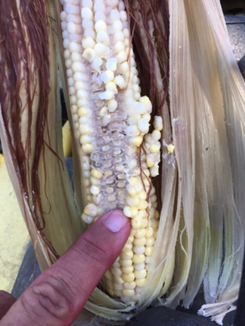Crop Insurance Won't Cover This
Data from the KY Mesonet site near Woodbury tell that we had slightly over 10 inches of rain during the first two weeks of July. Many places in the county saw rain totals even higher. According to USGS data, the Green River at Woodbury crested at nearly 35 feet on July 10. USGS (United States Geological Survey) calls flood stage 27 feet.
The flood was unprecedented in its timing. Much of our county’s corn was at pollination or beyond when the water was at its highest point. Many of our beans were small and were not able to withstand being under water. During and after the flooding, I visited with many farmers from around the county and determined that around six thousand acres of crop (corn and soybeans) were totally destroyed. This translates into an economic loss of around $3,600,000. Another six to eight thousand acres sustained damage because of the heavy rains or flooding. It is difficult to assign an economic loss value to those acres that were damaged.

Farmers will have to deal with weak stalks, developmental problems, disease, and poor quality grain come harvest time. All the rain also fell at a time when farmers needed, and in some cases still need, to apply crop protection chemicals to their growing crops. Weeds rob significant yield in corn and soybeans when they are not controlled. The incredible rain has left few opportunities for farmers and custom applicators to apply crop protection products. Grain farmers are facing difficult decisions on damaged fields. They can replant their soybeans knowing they can only reasonably expect 50% yield on the new planting because of late planting date, or they can live with damaged soybeans and see if they survive and make yield. Many fields were total destroyed and the decision is easy. Replant if possible.
Many people believe that the crop insurance program that many of our growers participate in will replace all this lost crop income. This is not likely. Many fields or farms only lost part of their acres to the flood and the remaining acres, that were not destroyed, will provide enough yield to keep crop insurance from making a payment. On farms where the entire crop is destroyed crop insurance will kick in and provide a payment, if the farmer participates in crop insurance. These payments will often only cover a farmer’s cash costs. They will not cover rent, land payment, or anything for family living expense.

Livestock farms have also suffered during this incredibly wet summer. Summer hay operations have been very difficult because we have had very few stretches of 4 days without rain. Hay has been cut at a later than desirable stage and often gotten wet before it was baled and stored for the winter. Both of these conditions cause loss of hay quality and ultimately livestock performance.
For more information, contact the Butler County Extension Office at 112 E GL Smith Street, Morgantown, or call 270-526-3767.
Educational programs of the Kentucky Cooperative Extension Service serve all people regardless of race, color, age, sex, religion, disability, or national origin.
By: Greg Drake II, County Extension Agent for Agriculture and Natural Resources
- Log in to post comments



























